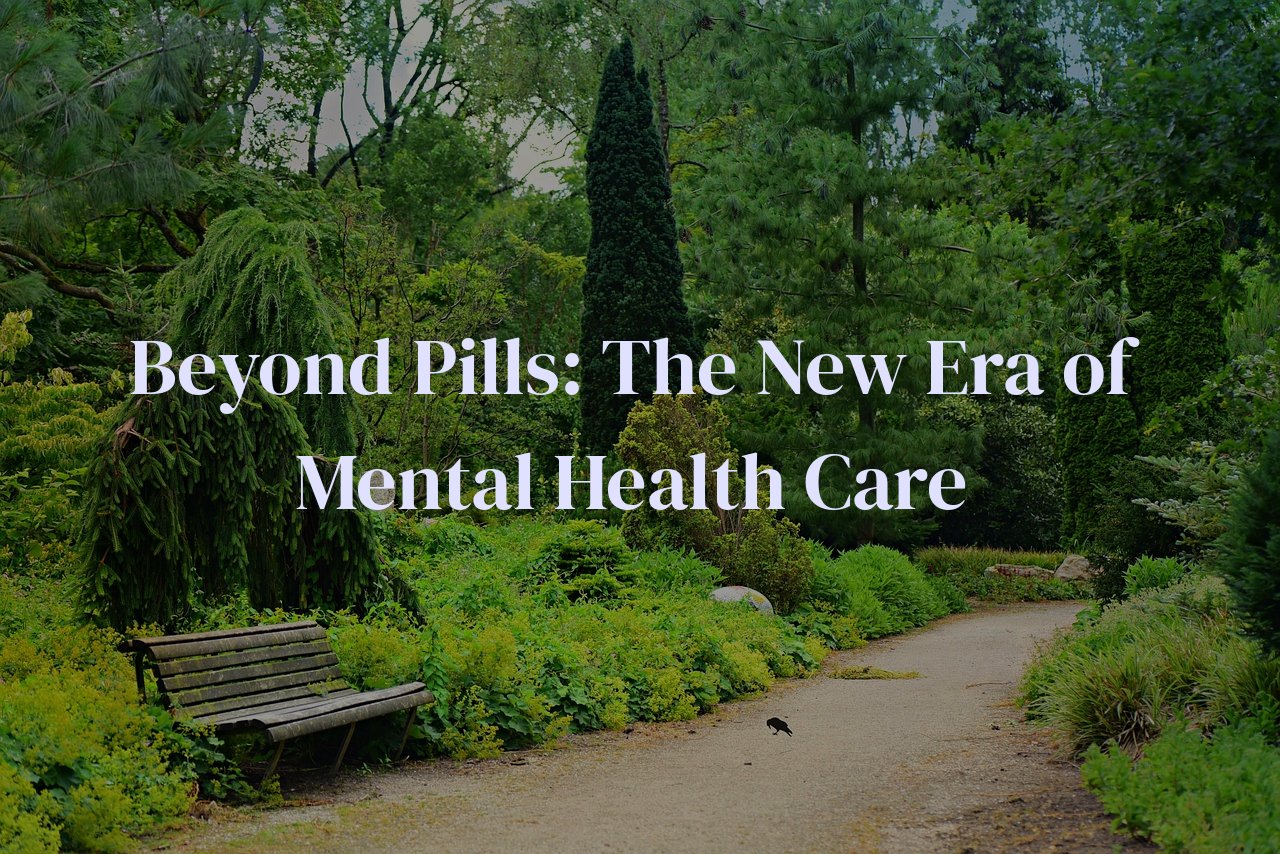
In this blog post, we will delve into the evolving landscape of mental health care, specifically examining alternatives to traditional pharmaceutical treatments. From innovative therapies to lifestyle modifications, the title encapsulates a shift towards a more holistic and varied approach to mental well-being.
By reading this post, you can discover cutting-edge non-pharmaceutical interventions, understand their benefits and applications, and see how these alternatives might fit into your own mental health strategy. Whether you’re exploring this for personal interest or professional growth, the insights shared here could enhance your perspective on mental health care.
Table of Contents
The Rise of Mindfulness and Meditation
In recent years, mindfulness and meditation have risen to prominence as essential non-pharmaceutical interventions for mental health. The beauty of these practices is their accessibility and the personalization they offer.
Mindfulness, in particular, is about being present in the moment, acknowledging one’s thoughts and feelings without judgment. It’s a powerful tool that helps individuals become more attuned to their mental state. I remember starting my own mindfulness journey years ago, initially with guided sessions. My skepticism faded as I noticed a tangible reduction in my anxiety levels and improved concentration.
Meditation, on the other hand, often involves quieting the mind to achieve a state of deep relaxation. There are various forms, such as transcendental meditation, loving-kindness meditation, and body scan meditation. I found loving-kindness meditation particularly impactful; it fostered a sense of empathy and compassion that I hadn’t experienced before.
Research backs up my personal experiences. Studies show mindfulness can reduce symptoms of stress, anxiety, and depression. It’s being integrated into therapeutic settings through techniques like Mindfulness-Based Stress Reduction (MBSR) and Mindfulness-Based Cognitive Therapy (MBCT). These programs offer structured ways to incorporate mindfulness into daily life, leading to lasting benefits.
Meditation, similarly, has shown to positively affect brain structure and function. MRI scans reveal changes in the amygdala and prefrontal cortex, regions tied to emotion regulation and cognitive processes. This scientific validation only strengthens the case for these practices.
Moreover, the digital age has made mindfulness and meditation more accessible than ever. Apps like Headspace and Calm offer guided sessions that can be practiced anytime, anywhere. I often use these apps during travel, finding that a quick session can reset my mental state amid a busy day.
In essence, the rise of mindfulness and meditation marks a significant shift in mental health care. It’s about harnessing the power within ourselves, leveraging ancient practices supported by modern science to cultivate a healthier mind. Whether you’re just beginning your journey or are a seasoned practitioner, these practices offer a path to mental well-being that’s both profound and accessible.
Therapeutic Value of Art and Music
It’s truly fascinating how art and music have time and again proven themselves to be powerful tools for mental healing. My personal journey with mental health has been brightened and relieved by the strokes of a paintbrush and the notes of a piano. In a world where pills seem to be the go-to solution, embracing such therapeutic avenues brings about a refreshing change.
Art therapy, for instance, involves the use of creative expression to foster healing and mental well-being. This can include painting, drawing, or even sculpting. When I first picked up a canvas, I didn’t realize how cathartic it would be. Art allows individuals to express emotions that they might not be able to verbalize, creating a safe space to explore and understand those feelings. The colors, shapes, and textures all contribute to a narrative that expands far beyond words.
Music therapy, on the other hand, harnesses the profound effect that melodies and rhythms have on our minds. Whether it’s through actively making music or simply appreciating it, this form of therapy can reduce anxiety, depression, and even physical pain. For me, the gentle strumming of a guitar can transport me to a place of tranquility, much like meditation but with a tuneful companion. Therapists often use specific frequencies and rhythms to target particular emotional or psychological needs, making this approach highly customizable and effective.
One of the most remarkable aspects of art and music therapy is their ability to foster connection and community. Engaging in group art projects or music sessions can build a sense of belonging and shared purpose. I’ve been part of community art classes where each person’s piece contributed to a larger, unified artwork, creating a tapestry of collective expression. Similarly, group drumming circles or choir practices have not only enhanced my musical skills but also brought me closer to others who understand the therapeutic power of rhythm and harmony.
Moreover, art and music therapies often involve a deep engagement with the senses, bringing about a meditative state that promotes mindfulness. When I’m lost in a painting or completely engrossed in a musical piece, my mind finds quietude. It’s as if the chaos of daily life fades away, replaced by moments of pure, unadulterated emotion and creativity.
In this modern era, where mental health is gaining more recognition and understanding, the unassuming yet profound influence of art and music stands out as a testament to the diverse avenues of healing available to us. They remind us that mental health care is not just about addressing what’s wrong but also nurturing what’s right within us, one brushstroke and one note at a time.
Nutrition and Mental Health: A Powerful Connection
When it comes to mental health, one of the most overlooked yet incredibly impactful factors is nutrition. The old saying ‘You are what you eat’ couldn’t be more true, especially for our mental well-being.
First off, let’s talk about Omega-3 fatty acids. Found in fatty fish such as salmon and mackerel, these essential fats play a crucial role in brain function and structure. Studies have shown that a deficiency in Omega-3 can lead to mood disorders and cognitive decline. Incorporating more Omega-3s into your diet could be as simple as enjoying a salmon salad or opting for a fish oil supplement.
Sugar, particularly refined sugar, is another major player. While a sugary snack might give you a temporary high, the long-term effects can be detrimental. High sugar consumption has been linked to depression and anxiety. In my own journey, I found that cutting back on sweets dramatically improved my mood stability. Swapping out sugary treats for fruits like berries or apples can make a world of difference.
Gut health is another fascinating area. Our gut is home to trillions of bacteria, many of which produce neurotransmitters like serotonin and dopamine. A diet rich in probiotics, commonly found in yogurt, kefir, and fermented foods, can help maintain a healthy gut flora, which in turn supports mental health. I’ve personally incorporated more fermented foods into my diet and noticed a considerable boost in my overall sense of well-being.
Complex carbohydrates such as whole grains, fruits, and vegetables can also have a significant impact. Unlike simple carbs, which can cause spikes and crashes in blood sugar levels, complex carbs provide a steady source of energy. This helps stabilize mood and reduces irritability. As someone who switched from white bread to whole grains, I can attest to feeling more balanced and less prone to mood swings.
Lastly, don’t underestimate the power of hydration. Dehydration can lead to cognitive impairments and mood disturbances. Drinking enough water throughout the day ensures that your brain functions at its best. I’ve made it a habit to carry a reusable water bottle wherever I go, and it has made a noticeable difference in my focus and energy levels.
In conclusion, nutrition offers a natural, powerful way to support mental health. By making mindful choices about what we consume, we can pave the way for a healthier, happier mind.
Physical Activity as a Mental Health Booster
As someone who has navigated the turbulent waters of mental health, I can attest to the transformative power of physical activity. It is more than just a tool for sculpting the body; it’s a vital cornerstone of emotional and psychological well-being. There are some mornings when the weight of the world feels too heavy to bear, but a brisk walk in the park or a morning yoga session reignites my spirit.
The Science Behind It: Physical activity triggers the release of endorphins—our brain’s feel-good neurotransmitters. These natural mood lifters act similarly to painkillers and can bring about feelings of euphoria, commonly referred to as the ‘runner’s high.’ Through consistent exercise, the body’s ability to manage stress improves, reducing symptoms of anxiety and depression.
Personal Journey: I remember a time when I struggled with severe anxiety. My therapist recommended incorporating regular exercise into my routine. At first, it seemed like climbing a mountain, but I started with light activities: a slow jog, a few minutes of stretching, and eventually, a structured workout regimen. Over time, I noticed a shift. My mind felt clearer, my moods more stable, and the anxiety that once felt insurmountable began to wane.
Types of Physical Activities: What works best can vary from person to person. For some, high-intensity interval training (HIIT) can be incredibly effective, while others may find solace in the slow, deliberate movements of yoga or tai chi. Personally, I find that a blend of cardio and strength training offers a balanced approach, addressing both physical and mental dimensions of health.
Outdoor Exercise: There’s something uniquely uplifting about outdoor exercise. Being surrounded by nature, breathing in fresh air, and feeling the sun on your skin can significantly boost your mood. I often take my exercise routines outside, combining physical activity with the grounding energy of nature. Whether it’s hiking through a forest trail or simply doing stretches in my backyard, the outdoors adds an extra layer of mental rejuvenation.
Group Activities and Social Connections: Exercising in a group setting can offer additional benefits. Classes like Zumba, spin, or even a local running club can provide a sense of community and shared purpose. For me, joining a local yoga class became a weekly highlight, not only for the physical benefits but also for the camaraderie and support from like-minded individuals.
Incorporating Mindfulness: Integrating mindfulness into physical activity can enrich the experience. Practices like mindful walking, where you focus on each step, the feel of your muscles, and your breath, can elevate both physical and mental benefits. I’ve found that incorporating mindfulness into my workouts makes the experience more holistic and deeply satisfying.
Consistency is Key: The positive effects of exercise on mental health are well-documented, but consistency is crucial. I set realistic goals and celebrate small victories. Some days, it’s a full workout; other days, it’s just a short walk. What matters is the commitment to move, to engage, and to prioritize both my physical and mental health.
While medication and therapy remain essential components of mental health care, physical activity offers a powerful, accessible, and generally side-effect-free avenue for mental well-being. It’s not a cure-all, but it’s a profoundly impactful tool that can complement other treatments. For anyone grappling with mental health challenges, I encourage you to give physical activity a try. You might just find that the key to emotional resilience is as simple as lacing up your sneakers.
Advanced Techniques: Virtual Reality and Biofeedback
As we journey further into the new era of mental health care, one cannot overlook the groundbreaking advancements in technology that are making waves in this field. Among these, Virtual Reality (VR) and Biofeedback have emerged as transformative tools with immense potential. Not only do they offer innovative approaches to mental health treatment, but they also empower individuals to actively participate in their healing journey.
Virtual Reality therapy immerses patients into a simulated environment, creating a safe space to confront and manage their fears, anxieties, or traumas. For instance, those suffering from PTSD can work with therapists to engage in controlled exposure therapy, gradually desensitizing themselves to triggers in a way that is both immersive and controlled. I recall my first experience with VR therapy. At first, it was surreal, almost like stepping into a different world. As the sessions progressed, I found myself confronting and navigating through my anxieties in a controlled, safe setting. It was a profound and eye-opening experience.
Biofeedback, on the other hand, allows individuals to gain real-time insights into their physiological responses. By monitoring indicators like heart rate, muscle tension, and skin conductance, patients can learn how to modulate these responses through techniques like relaxation and breath control. During one session, I remember being hooked up to a biofeedback device while my therapist guided me through deep breathing exercises. Watching my heart rate decrease in real time was incredibly empowering; it felt like reclaiming control over my own body and mind.
There are several key aspects of these advanced techniques that make them particularly effective. First, they offer an interactive and engaging experience. Traditional therapy sessions can sometimes feel static or intimidating, but VR and biofeedback bring a dynamic element that can increase patient engagement and motivation.
Second, these technologies provide quantifiable data. Whether it’s tracking your progress in a VR simulation or monitoring physiological changes through biofeedback, having tangible indicators can boost confidence and show concrete evidence of improvement.
Lastly, VR and biofeedback can be highly personalized. Sessions can be tailored to the individual’s specific needs, which enhances the efficacy of treatment. For example, I observed how biofeedback could be customized to focus on different stress response systems depending on patient needs. Similarly, VR environments can be adapted to address unique phobias or traumas for targeted therapy.
Advanced techniques like Virtual Reality and Biofeedback are not just futuristic novelties; they represent practical, effective, and personalized mental health care solutions. They break the mold of traditional therapy and offer unique opportunities for deeper, more engaged healing processes. It is an exciting time for mental health care as we continue to explore these innovative methods that go beyond the limitations of conventional pill-based treatments.
Conclusion
As we move beyond traditional pharmaceutical treatments, embracing a variety of non-pharmaceutical interventions can offer a richer, more personalized approach to mental health care. By integrating these innovative methods, we can enhance our well-being and pave the way for a brighter, healthier future.
Thank you for joining me on this journey to explore the next frontier in mental health interventions. I hope you find inspiration and practical insights to apply in your own life or practice.



